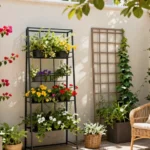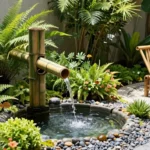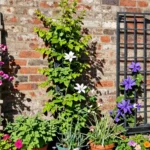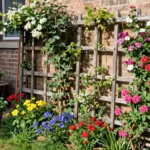Outdoor play doesn’t have to mean expensive equipment or elaborate setups. We’ve discovered that tuff trays offer the perfect solution for creating captivating sensory experiences right in your backyard. These versatile containers transform ordinary outdoor time into extraordinary learning adventures that keep kids entertained for hours.
We’re passionate about maximizing outdoor play because we know how crucial fresh air and hands-on exploration are for child development. Tuff trays give us the freedom to bring messy play outside where cleanup becomes effortless and creativity knows no bounds. From water play to nature exploration these simple containers unlock endless possibilities.
Whether you’re dealing with limited space or searching for budget-friendly entertainment options we’ve got you covered. Our collection of outdoor tuff tray ideas will inspire you to create memorable experiences that combine learning with pure fun. Let’s jump into creative setups that’ll transform your outdoor space into an adventure playground.
Nature Collection and Sorting Activities
Nature collection activities transform ordinary outdoor tuff trays into hands-on learning laboratories that encourage children to explore their natural environment. We’ve found these activities develop observation skills while building scientific thinking patterns through tactile exploration.
Leaf Classification by Shape and Color
Collecting different leaf varieties creates an captivating botanical exploration experience for young naturalists. We recommend gathering leaves from multiple tree species including oak, maple, birch, and pine to showcase diverse shapes and textures. Children can sort these natural specimens by characteristics like serrated edges, smooth borders, or pointed tips.
Setting up classification stations helps organize the learning process effectively. We suggest using small containers or sections within the tuff tray to separate leaves by color families such as green, yellow, red, and brown. Kids naturally develop pattern recognition skills when they group similar specimens together.
Creating leaf rubbings adds an artistic element to the scientific exploration. We place paper over different leaves and use crayons to capture their unique vein patterns and shapes. This activity strengthens fine motor skills while preserving the natural discoveries for future reference.
Rock and Stone Exploration Station
Gathering various rock specimens provides endless opportunities for geological discovery. We collect smooth river rocks, rough granite pieces, colorful quartz crystals, and sedimentary stones to demonstrate different formation processes. Children learn to identify characteristics like texture, weight, and mineral composition through hands-on investigation.
Sorting rocks by size creates mathematical learning opportunities within the nature exploration. We arrange stones from smallest pebbles to largest specimens, introducing concepts like measurement and comparison. Kids enjoy stacking different sized rocks to build towers and explore balance principles.
Water exploration with rocks reveals fascinating scientific properties. We add shallow water dishes to the tuff tray so children can test which stones float or sink. This experiment introduces density concepts while demonstrating how different rock types interact with water.
Seed and Pod Discovery Tray
Collecting seed pods from various plants introduces children to plant reproduction cycles. We gather acorns, pinecones, maple helicopters, dandelion puffs, and milkweed pods to showcase different seed dispersal methods. Children discover how nature designed each seed type for exact survival strategies.
Opening different pod types reveals hidden treasures inside each specimen. We provide magnifying glasses so kids can examine tiny seeds, fluffy dispersal mechanisms, and protective casings up close. This investigation builds curiosity about plant life cycles and adaptation strategies.
Planting discovered seeds extends the learning experience beyond the tuff tray activity. We show children how to prepare small pots with soil for germinating their collected specimens. This long-term project connects outdoor exploration with indoor gardening while teaching patience and plant care responsibilities.
Water Play and Sensory Exploration
Water transforms tuff trays into ever-changing learning environments where children can explore scientific concepts through hands-on experimentation. These activities promote fine motor skills while encouraging sensory discovery and imaginative play.
Mini Water Industry with Floating Objects
Creating a miniature aquatic environment captivates children’s imagination while introducing basic physics concepts. We recommend filling your tuff tray with water and adding sand around the edges to create realistic beach scenes. Small toy boats, plastic figurines, and collected shells turn the space into an interactive water industry where children can create their own stories.
Floating experiments become natural extensions of this play setup. We suggest gathering various household objects like cork pieces, plastic lids, wooden blocks, and metal spoons for children to test. They’ll discover which materials float or sink while developing critical thinking skills through hands-on observation.
Storytelling opportunities emerge as children create waterways and navigate their floating vessels through imaginary adventures. This combination of sensory exploration and creative play supports both cognitive development and imaginative thinking.
Ice Melting Science Experiments
Ice investigation activities introduce children to states of matter through tactile exploration. We place ice cubes directly in the tuff tray or use small containers within the setup to create controlled melting experiments. Adding food coloring to the ice beforehand creates colorful melting patterns that capture children’s attention.
Salt experiments demonstrate how different substances affect melting rates. We sprinkle table salt on some ice cubes while leaving others untreated, allowing children to observe and compare the melting process. This hands-on approach makes abstract scientific concepts tangible and memorable.
Prediction activities enhance the learning experience as children guess which ice cubes will melt fastest. We encourage them to discuss their observations and explain what they notice, building both vocabulary and scientific reasoning skills.
Rain Cloud Formation Activity
Weather pattern demonstrations become captivating when we recreate rain cloud formation in tuff trays. We layer water at the bottom, add shaving foam to represent clouds, and then drop colored water through the foam to simulate rainfall. This visual representation helps children understand how precipitation occurs in nature.
Cause and effect relationships become clear as children watch the colored water penetrate the foam layer. We use blue food coloring to represent rain, creating a realistic demonstration that combines visual learning with tactile exploration.
Hands-on weather education emerges as children manipulate the materials and observe the results. They can create multiple “rain events” by adding more colored water, reinforcing their understanding of weather patterns through repeated experimentation.
Garden-Themed Learning Adventures
Transform your outdoor tuff tray into a living classroom where children discover the wonders of gardening and nature. These garden-themed activities combine hands-on learning with imaginative play, creating unforgettable outdoor experiences.
Miniature Fairy Garden Creation
Create magical miniature worlds using natural materials collected from your garden or local park. Children can design enchanting fairy gardens by arranging leaves, flowers, stones, and miniature figures within the tuff tray’s contained space.
Collect natural materials like colorful autumn leaves, small pebbles, twigs, and flower petals to build fairy houses and pathways. Add miniature accessories such as tiny figurines, small mirrors for ponds, and dollhouse furniture to complete the magical scene.
Encourage storytelling as children create narratives about their fairy inhabitants and their garden adventures. Rotate materials seasonally to keep the activity fresh and exciting, incorporating pinecones in winter, fresh flowers in spring, and colorful leaves in autumn.
Herb and Vegetable Planting Station
Set up a contained mini garden that teaches children about plant growth, responsibility, and nutrition. Your tuff tray becomes a practical planting station where kids can handle seeds, soil, small pots, and child-sized gardening tools safely.
Start with easy-to-grow herbs like basil, mint, and chives that germinate quickly and provide immediate gratification. Include fast-growing vegetables such as radishes, lettuce, and cherry tomatoes that children can harvest and taste within weeks.
Provide child-sized tools including small watering cans, plastic shovels, and measuring cups for portion control. Create planting charts where children can track their seeds’ progress, measuring growth and recording observations in a garden journal.
Connect learning to meals by incorporating harvested herbs into family cooking, showing children the complete cycle from seed to plate. Discuss plant needs like sunlight, water, and nutrients while children tend to their miniature garden.
Bug Hunt and Insect Investigation
Turn your tuff tray into an outdoor laboratory for safely observing insects and small creatures. This activity enhances children’s curiosity about biodiversity while teaching respect for living creatures.
Provide magnifying glasses and collection containers with air holes for temporary insect observation. Create observation sheets where children can draw and record details about insects they discover, including size, color, and behavior patterns.
Establish gentle handling rules that emphasize releasing creatures back to their natural habitats after brief observation periods. Include reference books about common garden insects to help children identify their discoveries and learn about insect life cycles.
Extend sensory exploration by collecting textures like smooth stones, rough bark, and soft moss during bug hunting expeditions. Document findings with photographs or drawings that children can share with family members, reinforcing their learning experience.
Incorporate seasonal changes by discussing which insects appear during different times of year and how they adapt to weather conditions.
Seasonal Weather Exploration
We can transform our tuff trays into fascinating weather laboratories that help children understand seasonal changes through hands-on investigation. These activities encourage observation and classification skills while captivating multiple senses in outdoor learning environments.
Snow and Ice Investigation Tray
Fill your tuff tray with ice cubes and homemade ice shapes to create an captivating winter science station. We recommend adding salt, food coloring, and small tools like droppers and magnifying glasses to enhance the exploration experience. Children can observe how salt affects melting rates and watch colorful patterns form as food coloring spreads through the ice. Snow can be added when available to provide texture comparison opportunities.
Temperature investigation becomes exciting when children use their hands to feel different ice formations. We suggest creating ice shapes in various containers beforehand, allowing kids to discover how thickness affects melting speed. The contained environment of the tuff tray keeps the cold materials manageable while preventing mess from spreading throughout your outdoor space.
Scientific curiosity develops naturally as children observe states of matter changing before their eyes. We encourage parents to ask open-ended questions about what they notice happening to the ice over time. This sensory investigation introduces concepts about temperature changes and matter transformation in an accessible way for young learners.
Autumn Harvest Sensory Bin
Create a rich tactile experience using collected autumn elements like pine cones, acorns, and colorful leaves. We recommend gathering these materials during nature walks, making the collection process part of the learning adventure. Small pumpkins, gourds, and various seeds add diverse textures and shapes for exploration. Dried corn kernels provide additional sensory input and make satisfying sounds during play.
Sorting activities emerge naturally when children encounter this variety of autumn materials. We suggest encouraging classification by color, size, or texture to develop early math skills. Children can create patterns with their collected items or engage in pretend play scenarios using the natural harvest bounty. The varied textures support fine motor skill development as little hands manipulate different objects.
Seasonal learning becomes concrete when children can touch and examine real autumn specimens. We find that this hands-on approach helps children understand seasonal changes better than abstract discussions. The tuff tray contains the materials while allowing freedom to explore, sort, and create with nature’s autumn offerings.
Spring Growth Observation Station
Transform your tuff tray into a mini garden where children can plant seeds and observe growth over time. We recommend including soil, various seeds or bulbs, small pots, child-sized gardening tools, and watering containers. This setup creates an accessible gardening experience that doesn’t require a large garden space. Children can choose their own seeds to plant, fostering ownership and responsibility.
Daily observation becomes an exciting routine when children track their plants’ progress. We suggest providing a simple chart or journal where kids can draw or mark changes they notice. Measuring plant growth with rulers introduces basic math concepts while documenting the plant life cycle. This long-term project teaches patience and the rewards of consistent care.
Scientific understanding develops as children witness the complete plant growth process firsthand. We encourage discussions about what plants need to grow, connecting care activities to plant health outcomes. The contained environment allows for easy watering and soil management while keeping the growing area organized and accessible for young gardeners.
Construction and Building Challenges
Transform your tuff tray into an captivating construction site that builds children’s engineering skills while they explore hands-on building concepts. These activities combine physical play with cognitive development through structured building challenges.
Outdoor Block Building Zone
Create a construction headquarters by filling your tuff tray with sand, wood chips, and small logs to simulate a real building site. Children can transport materials using toy diggers and construction vehicles while learning basic engineering principles through play.
Incorporate alphabet stones into the sand mixture to boost literacy skills alongside construction activities. Toddlers can practice spelling words while manipulating building materials, creating connections between language development and hands-on construction play.
Set up designated zones within the tray for different construction phases like foundation laying, material storage, and building assembly. This organization helps children understand sequential building processes while developing planning and problem-solving abilities.
Add measuring tools like rulers and measuring cups to encourage mathematical thinking during construction projects. Children can measure sand quantities, compare log lengths, and discuss concepts like bigger, smaller, taller, and shorter through their building activities.
Natural Material Engineering Projects
Gather outdoor materials like flowers, leaves, and plant parts to create sorting challenges that promote early engineering thinking. Children can categorize materials by color, size, texture, and shape while exploring natural construction possibilities.
Design flower towers using collected blooms and stems to teach structural stability concepts. Kids learn balance principles as they stack materials and discover which combinations create the strongest towers through trial and error experimentation.
Build leaf bridges by connecting different leaf types to span gaps in the tray setup. This activity introduces basic engineering concepts like span, support, and load distribution while children test which leaf combinations create the most effective bridges.
Create natural sorting stations by drawing sections in the tray where children organize outdoor finds by properties. This systematic approach develops classification skills essential for understanding engineering design and material selection processes.
Sand and Gravel Construction Site
Fill the tray completely with sand and small pebbles to create a realistic construction environment for tactile building experiences. Children manipulate materials using toy diggers and construction equipment while developing fine motor skills through hands-on material handling.
Include crushed cereal alternatives like Weetabix pieces as safe building blocks that children can explore without safety concerns. This edible option allows younger children to experiment with texture and construction concepts in a controlled, taste-safe environment.
Design building challenges that require exact material combinations like creating roads with sand and walls with pebbles. These structured activities help children understand material properties while encouraging creative problem-solving through construction play.
Integrate water elements gradually to show how moisture affects construction materials and building stability. Children observe how wet sand behaves differently than dry sand, learning fundamental concepts about material properties and construction challenges.
Animal Habitat Recreations
Transform your tuff tray into realistic ecosystems where children can explore different animal habitats through hands-on play. These habitat recreations spark curiosity about wildlife while developing scientific observation skills.
Pond Life Network Tray
Creating a pond network in your tuff tray brings aquatic learning directly to your outdoor space. Fill the tray with water and add natural pond elements like smooth pebbles, floating leaves, and aquatic plants to simulate a real pond environment. Children can explore concepts of floating and sinking while observing how different materials interact with water.
Introduce toy frogs, fish, and water insects to populate your miniature pond network. We recommend using realistic animal figures that help children learn about pond dwellers and their behaviors. Watch as kids discover which animals live in water versus those that visit ponds occasionally.
Add lily pads made from large leaves or foam cutouts to create resting spots for toy animals. This setup encourages storytelling as children imagine how different creatures use the pond throughout the day. The sensory experience of water play combined with educational content makes this tray particularly captivating for young learners.
Forest Floor Animal Homes
Collect natural materials like moss, bark pieces, twigs, leaves, and pine cones to recreate an authentic forest floor experience. Layer these materials in your tuff tray to build different textures that mirror what children might find during forest walks. The variety of natural elements provides rich sensory exploration opportunities.
Position miniature woodland animals such as hedgehogs, owls, beetles, and small mammals throughout the forest floor setup. Children learn about animal shelters and how creatures adapt to forest environments through hands-on discovery. We suggest hiding some animals under leaves or behind bark pieces to create exciting search and find games.
Encourage kids to build tiny homes for different animals using the collected materials. This activity develops fine motor skills while teaching about forest ecology and animal habitats. Children can create burrows, nests, and hiding spots that match each animal’s natural living preferences.
Desert Industry with Toy Animals
Sand or sandy textured materials form the perfect base for desert habitat recreation in your tuff tray. Add small rocks, pebbles, and succulent plants or cacti replicas to create an authentic desert industry. The varied textures provide excellent tactile experiences while introducing children to dry network concepts.
Desert animal toys like lizards, snakes, camels, and scorpions help children understand which creatures thrive in harsh desert conditions. We recommend discussing animal adaptations such as how desert animals conserve water and stay cool in hot temperatures. This educational play sparks curiosity about survival strategies in extreme environments.
Create sand dunes and rocky outcrops where animals can hide from the desert sun. Children can practice burying and uncovering animals while learning about desert animal behaviors. The combination of realistic industry features with imaginative play creates captivating learning experiences about one of Earth’s most challenging habitats.
Messy Play and Art Creation
We transform our tuff trays into creative zones where children can explore textures and express themselves freely without worrying about cleanup. These contained spaces allow for unlimited artistic exploration while keeping the mess manageable outdoors.
Mud Kitchen Cooking Station
Transforming your tuff tray into a mud kitchen requires simple additions like bowls, cups, spoons, and natural ingredients mixed with mud and water. Children create mud pies and flower soups while captivating in imaginative role play that develops their creativity and social skills. Safety becomes a priority when we introduce edible alternatives such as cornflour mixed with water or cocoa powder for younger children who might taste their creations.
Utensils from your kitchen drawer work perfectly for this setup, encouraging children to mimic real cooking experiences. Collaboration flourishes as children share materials and exchange “recipes” with their friends during outdoor play sessions. Natural ingredients like leaves, flowers, and small stones add texture and visual appeal to their culinary masterpieces.
Natural Paint Making Workshop
Natural paint creation uses mud, crushed flower petals, berries, and vegetable dyes placed in separate sections of your tuff tray for color experimentation. Children mix different textures and colors while developing their fine motor skills through hands on exploration. Scientific thinking emerges as they discover which natural materials produce the brightest colors or most interesting textures.
Portable workshops can be set up quickly using materials collected from your backyard or local park. Environmental benefits include reducing synthetic art supplies while connecting children directly with nature’s creative potential. Flower petals create beautiful purples and pinks, while mud provides earthy browns that children love to blend with other natural pigments.
Clay Sculpting with Natural Tools
Clay or natural modeling materials paired with tools crafted from sticks, stones, shells, and leaves create an captivating sculptural experience in your tuff tray. Children develop tactile awareness as they explore different shapes and forms using nature’s own implements. Fine motor skills strengthen through the precise movements required for detailed clay work.
Natural tools spark imaginative play as children discover that different objects create unique textures and patterns in their clay creations. Sticks become detail carvers while smooth stones work as rolling tools for flattening clay surfaces. Contained mess management allows children to focus entirely on their artistic vision without worrying about cleanup constraints.
Science Experiment Stations
Science experiment stations transform our tuff trays into outdoor laboratories where children can explore scientific concepts through hands-on discovery. We can create captivating demonstrations that spark curiosity about chemistry, biology, and weather patterns while maintaining safe learning environments.
Volcano Eruption Demonstration
Volcano eruption demonstrations turn our tuff trays into contained stations for classic chemistry experiments. We place baking soda and vinegar inside miniature volcano models, allowing children to create safe chemical reactions while observing the bubbling eruption process. The tray contains any mess and provides close observation opportunities for young scientists.
Chemical reactions become visible and exciting when we add food coloring to create different colored eruptions. Children can experiment with varying amounts of baking soda and vinegar to see how proportions affect the intensity of their volcanic displays. We encourage predictions about what will happen before each eruption, developing critical thinking skills through hands-on chemistry exploration.
Safety remains our top priority as we supervise all chemical mixing activities and ensure children understand proper handling procedures. Multiple small volcanoes can be created within one tray, allowing groups of children to conduct simultaneous experiments. We can extend the learning by discussing real volcanic activity and connecting the demonstration to earth science concepts.
Plant Growth Observation Tray
Plant growth observation trays transform our outdoor spaces into botanical research stations where children investigate seeds and plant development. We collect various seeds from the local environment and place them in soil filled sections of the tray, creating controlled growing conditions for detailed study. Children can observe differences in seed shapes, sizes, and colors while tracking growth patterns over time.
Botanical investigations become more meaningful when we provide magnifying glasses and measurement tools for detailed observations. We encourage children to maintain growth journals, recording daily changes in their plant specimens and noting environmental factors that affect development. Water levels, sunlight exposure, and soil conditions can all be manipulated to teach cause and effect relationships in plant biology.
Different growing mediums like soil and water allow for comparative studies within the same tray setup. We can plant identical seeds in various conditions to demonstrate how environmental factors influence plant growth rates. Children develop patience and responsibility through daily care routines while learning about plant life cycles and botanical science.
Weather Pattern Investigation
Weather pattern investigations turn our tuff trays into meteorological laboratories where children explore atmospheric phenomena through practical experiments. We simulate rain using spray bottles and observe how water affects different materials placed in the tray, teaching concepts about precipitation and absorption. Wind effects can be demonstrated using small fans to show how air movement impacts lightweight objects like leaves and paper.
Evaporation and condensation experiments become fascinating when we add water containers at different temperatures within the tray setup. Children can observe how heat affects water transformation and watch condensation form on various surfaces. We incorporate soil, sand, and rocks to demonstrate how different materials respond to weather conditions and temperature changes.
Temperature variations create opportunities for hands-on learning about weather patterns and seasonal changes. We can freeze water in small containers overnight and observe melting rates during outdoor play sessions. Children make predictions about which materials will retain heat longer and test their hypotheses through systematic observation and measurement activities.
Treasure Hunt and Discovery Games
Tuff trays create perfect miniature adventure zones where children can experience the thrill of discovery right in their own backyard. These interactive games combine the excitement of treasure hunting with valuable learning opportunities that develop observation skills and cognitive abilities.
Buried Treasure Archaeology Dig
Archaeological excavation becomes an captivating adventure when we transform our tuff tray into a professional dig site. Fill the tray with soil, sand, or even flour to create a safe digging medium that contains hidden treasures waiting to be discovered. Small artifacts like toy dinosaurs, coins, or themed objects can be buried at different depths to create varying levels of difficulty.
Children develop fine motor skills as they carefully excavate using small brushes, spoons, or toy shovels to uncover their findings. This hands-on approach fosters patience and scientific inquiry while providing rich sensory experiences through varied textures. We can enhance the archaeological theme by providing magnifying glasses and encouraging children to document their discoveries in a field journal.
Safety remains paramount when selecting digging materials, with edible options like cornflour mixed with water offering peace of mind for younger explorers. The excavation process teaches children about careful observation and gentle handling of discovered items, skills that translate to real-industry scientific thinking.
Hidden Object Search and Find
Visual discrimination skills flourish when children engage in carefully designed hidden object challenges within their tuff tray environment. Scatter small themed items among filler materials like rice, beans, or natural elements to create captivating search experiences that require focused attention and systematic exploration.
Exact search criteria can be introduced by asking children to find objects of particular colors, shapes, or sizes, reinforcing early math concepts through play. This activity promotes vocabulary development as children discuss their findings and describe the characteristics of discovered items. We can increase difficulty by introducing items that blend with the background materials, challenging children to use closer observation skills.
Multiple search rounds keep the activity captivating, with new objects introduced or search parameters changed to maintain interest. The contained environment of the tuff tray ensures that small objects remain within reach while providing enough space for thorough exploration.
Magnetic Item Collection Challenge
Scientific exploration takes on new dimensions when we introduce magnetic discovery games that combine treasure hunting with early physics concepts. A magnetic wand becomes the primary tool for distinguishing between magnetic and non-magnetic objects hidden within the tuff tray materials.
Children test various items to determine their magnetic properties, turning play into a simple science experiment that promotes exploration and early scientific reasoning. We can include a mix of magnetic items like paper clips, washers, and small metal toys alongside non-magnetic objects to create sorting challenges that reinforce classification skills.
The collection process encourages prediction as children hypothesize which items will be attracted to the magnet before testing their theories. This hands-on approach to learning about magnetism provides concrete experiences that help children understand abstract scientific concepts through direct observation and experimentation.
Conclusion
We’ve shared dozens of creative outdoor tuff tray ideas that’ll transform your backyard into an exciting learning playground. These activities prove that meaningful education doesn’t require expensive equipment or elaborate setups.
The beauty of outdoor tuff tray play lies in its flexibility – you can adapt any activity to match your child’s interests and developmental stage. Whether they’re fascinated by construction challenges or drawn to nature exploration we’ve got options that’ll keep them engaged for hours.
Remember that the best outdoor learning happens when children feel free to explore mess and experiment without restrictions. These tuff tray setups provide that perfect balance of structure and creative freedom.
Start with one or two activities that spark your child’s curiosity and watch as their confidence and skills flourish through hands-on discovery. Your outdoor space is about to become their favorite classroom.
Frequently Asked Questions
What are tuff trays and why are they good for outdoor play?
Tuff trays are shallow, durable plastic containers that create contained play spaces for children. They’re perfect for outdoor activities because they’re easy to clean, portable, and versatile. They allow for messy sensory play while keeping materials contained, making cleanup simple for parents while providing engaging learning experiences.
What age groups can use tuff tray activities?
Tuff tray activities can be adapted for children from toddlers (18 months) to early elementary age (8+ years). Younger children benefit from simple sensory exploration, while older kids can engage in more complex scientific experiments, construction challenges, and detailed nature investigations within the same tray setup.
How do I clean up after messy tuff tray activities?
Tuff trays are designed for easy cleanup. Simply hose them down outdoors or wipe with a damp cloth. For sticky materials, use warm soapy water. Most natural materials can be composted, while water-based activities drain easily. The contained nature of tuff trays prevents mess from spreading.
What materials do I need to start tuff tray activities?
Basic materials include natural items like leaves, rocks, sticks, and water. Household items like measuring cups, spoons, and small containers work well. Many activities use free materials from your yard or local park, making tuff tray play budget-friendly and accessible for all families.
Can tuff tray activities be educational?
Absolutely! Tuff trays naturally incorporate STEM learning through hands-on exploration. Children develop science skills through experiments, math concepts through sorting and measuring, engineering skills through building challenges, and literacy through vocabulary expansion. They learn while playing, making education enjoyable and memorable.
How do I set up tuff tray activities for different seasons?
Seasonal setups use materials relevant to each time of year. Spring trays might include seeds and growing plants, summer focuses on water play, autumn features harvested materials and leaves, while winter incorporates snow and ice experiments. This keeps activities fresh and connects children to natural cycles.
Are tuff tray activities suitable for small outdoor spaces?
Yes! Tuff trays are perfect for small spaces like apartment balconies, small patios, or tiny backyards. They contain activities in a compact area while still providing rich sensory experiences. Many activities require minimal setup space but offer maximum learning and play value.
How can I incorporate learning objectives into tuff tray play?
Focus on specific skills like counting with natural materials, letter recognition with nature items, or scientific observation through experiments. Create challenges that encourage problem-solving, hypothesis testing, and creative thinking. The hands-on nature of tuff tray activities naturally supports multiple learning objectives simultaneously.


































